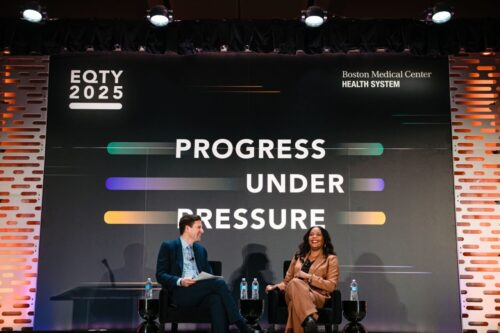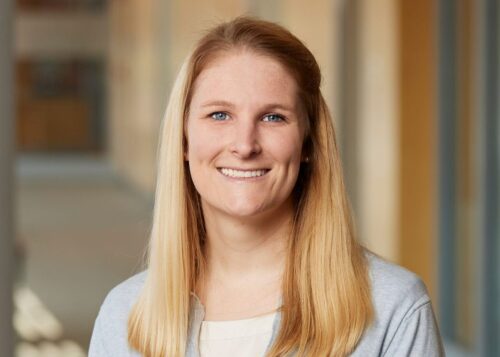Teen Parents Have a Unique Set of Needs; This Program Aims to Meet Them
December 6, 2022

Getty Images
"Teen and Tot was serving a population that needed somebody whose aim was not to keep them down but rather to push them forward."
Teen pregnancy rates have been on the decline for the last few decades, but disparities still persist in historically disinvested communities, which still have the highest rates of teen pregnancy and parenthood. Further, many teen parents are caught in a cycle of teenage parenthood, which is still linked to economic stagnation, gaps in education, and other factors that contribute to the cycle. These gaps in resources can lead to gaps in healthcare access — which is where the Teen and Tot Program at Boston Medical Center steps in.
Teen and Tot provides a wide range of medical and social services to teenage parents and their babies, including pre- and postnatal support groups through BMC’s CenteringPregnancy.
More recently, the Teen and Tot Program created the Student-Run Teen and Tot Service (SRTTS), which in partnership with Boston University Chobanian & Avedisian School of Medicine, integrated medical, social work, and public health students into the clinic to utilize their burgeoning clinical skills and learn more about the complex social needs of this patient population.
To understand more about the unique care the Teen and Tot program provides to its young patients and the ways in which the student-run portion has benefitted both student and patient, HealthCity spoke to Natalie Joseph, MD, MPH, who was medical director of the program for nearly 20 years, and Hilana Scott, MSN, RN, CPNP-PC, CLC, current medical director.
HealthCity: How did the Teen and Tot program start and how, in your experience, does it meet the needs of teen parents and their children?
Natalie Joseph, MD, MPH: The Teen and Tot program, initiated by Dr. Barry Zuckerman, began in 1971, and was focused on serving teenage mothers age 17 and younger — though we currently serve women age 20 and younger. In 2001, I came on board as the medical director for Teen and Tot — and though I recently left my position with the Teen and Tot program, to lead the only U.S. funded research on vaccine cancer prevention research here at BMC, I still feel very connected to working with young parents and their children.
Initially, I was drawn to the unique service-providing opportunity for both children and adolescents. Teen and Tot was serving a population that needed somebody whose aim was not to keep them down but rather to push them forward. The program was working upstream in that it provided opportunities for these young people to move forward.
“Teen and Tot was serving a population that needed somebody whose aim was not to keep them down but rather to push them forward.”
Teen and Tot remains a unique program among all programming in Massachusetts. It is the only program that offers prenatal care and postpartum care in the same site. These pregnant and parenting young women have the opportunity to have a much longer continuity of care, so that while they’re pregnant, they receive care and after they give birth, they can continue to receive care as well as support staff, such as nurse, case manager, social worker, and family planning.
Hilana Scott, MSN, RN, CPNP-PC, CLC: We provide primary care to teen moms and babies, but we also provide many other services specific to this population. In order to ensure we are providing the necessary care to mom and baby, we do what we call “dyadic care,” utilizing a two- or multi-generation approach to providing services by caring for both the child and the parent or caregiver. Our hope is that by providing this dyadic care for families we’re helping to support positive parent-child interactions.
HC: What is unique about this population and how does the program support that?
NJ: I am a pediatrician and an adolescent medicine specialist, I partner with obstetric providers for prenatal care and birth, and I offer age-appropriate pediatric and adolescent primary care, providing dyad care to parent and child — we have become like a mini family medicine catered to pregnant and parenting teens and their children.
When I first joined the program, I recognized that there are multiple factors at play contributing to teenage pregnancies. Family issues, socioeconomic challenges, education, and mental health struggles all contribute to why a teenager may become pregnant — and all of which intersect with culture.
HS: Adolescents are still very much developing themselves. They’re going through a large brain development where they’re thinking through decision-making, risk-versus-reward, and creation autonomy. Think about it: At 15, a child’s development is different than that of someone who is 21 or 22. I think that brings some unique features in terms of how they understand and relate to their children and how they think through parenting decisions. This is very different than what I see with a parent who is in their thirties or forties.
Further, these young parents have medical and social needs that also need to be met. Parents in general are a lot better about getting care for their children than for themselves. In this case, that parent is an adolescent and by providing care, we hope the needs of the adolescent are met, and we can support good health for parent and child.
HC: Because an adolescent parent has a lot of needs, what medical and social services does this program offer and how are these services unique in helping teens and their infants with short- and long-term goals?
HS: Our goal is to provide primary care but also wraparound services to support all aspects of the teen’s life. There are two clinicians: me and Lucy Marcil. We also have a social worker who can provide mental health support and a family planner who helps parents think through their goals and how we can help you achieve those goals.
Historically, we have had a community health worker (CHW) or case manager to help provide hands-on support for the resource needs of our families. Like the rest of our BMC population, our teen parents have many resource needs and sometimes we need to provide a little extra support to get them what they need. For example, CHWs can go to the Department of Transitional Assistance office with them and help to fill out paperwork and forms. The CHW’s role is really important in this process and has been a huge benefit to our program in the past.
NJ: The program is funded by the Boston Public Health Commission with a program that they call Boston Healthy Start Initiative that funds primary the full time position for our CHW. Having this support allowed me to integrate case management, care coordination, and advocacy work into the program, starting during prenatal care. Further, these young women would be matched with a social worker and a nurse who will remain coupled with the mother and infant until the infant is about 3 to 4 years old.
HC: Can you elaborate on the emergence of the Student-Run Teen and Tot Service?
NJ: The goal of SRTTS was, for me, to really train these medical students on how to interview and communicate with parents, enhance their awareness of the social determinants of health, and open their eyes to a different part of pediatrics. Often, when these medical students think of Pediatrics, it’s adult-parent and child. By including them in this opportunity, they are given the view of seeing an adolescent parent and their child.
It is important to note that I opened the SRTTS to undergrad students, public health students, and social work students so that it would truly emulate a free mini clinic with social workers, case managers, nurses, doctors, and others working side by side to provide holistic care. I was there to train medical students, but all students would have the opportunity to understand the social and medical needs, the gap in knowledge, and the gap in care that is needed for this underserved and very vulnerable population.
The hope is to empower the medical students in their confidence and history-taking and deliver health education to parents to increase their understanding of their child’s age-appropriate developmental milestones. One of our goals is to really get the medical student familiar with the vulnerable population and the dyadic type of care we provide.
HC: What do you envision the future of Teen and Tot to look like?
NJ: My goal is to expand the program to have a provider for teen fathers. Programming that includes fathers promotes involvement with their families before, during, and after the birth of their children. By involving the dad, there can be a major improvement in the child’s emotional wellbeing.
My other hope is that we can become a training site for other institutions, teaching them how to understand pregnant and parenting teens, who have such unique needs but also hopes and aspirations. I want to break the cycle of intergenerational economic insufficiency, repeated pregnancy, unemployment, and homelessness — it doesn’t have to be that way.
The overall goal for Teen and Tot aligns with our Pediatrics department — which is to create a fully staffed Teen and Tot specialized clinic-wide culture that is anti-racist and prioritizes diversity, equity, and inclusion as an essential component of our work.
This interview has been edited and condensed for clarity and length.


